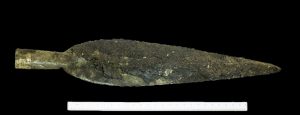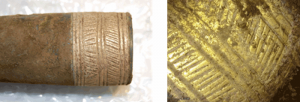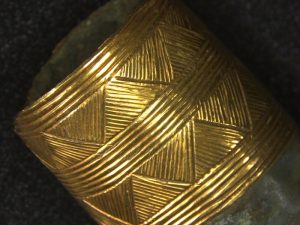
the Carnoustie spearhead
The Carnoustie spearhead was probably the star find of the dig. But it’s not the only gold decorated bronze spearhead to be found in this part of Scotland.

Pyotdykes spearhead © The McManus: Dundee’s Art Gallery and Museum
Another Bronze Age hoard was recovered at Pyotdykes farm just outside Dundee in 1963 and it too includes a gold decorated bronze spearhead. Indeed the discovery of the Carnoustie hoard spurred one of the specialists involved in our post-excavation programme of works, Alison Sheridan of the National Museums of Scotland to re-examine the Pyotdykes artefacts – two swords and the spearhead – which are held by The McManus – Dundee’s Art Gallery and Museum.

details of gold decoration of Carnoustie spearhead socket
Though a different shape to the Carnoustie spearhead, it is again the socket of the Pyotdykes spearhead which is embellished with a gold strip. The decoration on the Carnoustie band is decorated with a herringbone design between zones of two to three concentric lines,

detail of gold decoration around Pyotdykes spearhead socket. Photo by Lore Troalen of NMS
The Pyotdykes band has a more elaborate scheme featuring filled triangles between zones of up to seven lines. In each case, the design was probably incised into the end of the bronze socket, and then a seamless hoop of thin gold foil was slipped over the end and pressed in, to take the design.
One of the Pyotdykes swords had been buried in a scabbard made from hazelwood, just as the Carnoustie sword had been. As with the Carnoustie hoard, this proved really useful in providing suitable material for radiocarbon dating. The Pyotdykes hoard is now dated to 900–790 BC, slightly later than the Carnoustie Hoard which was dated to between 1118-924 BC.
The dates are interesting because they suggest that the two hoards were probably not contemporary with each other but may have been separated in time by as much as 300 years. This makes the similarities between the hoards all the more fascinating because while these suggest a similar idea behind why they were buried – perhaps safe-keeping rather than ritual given that the Carnoustie hoard lies within the middle of a settlement unlike most hoards which were deposited in watery places (rivers, bogs, lochs) – it was not one event that spurred this. This cultural custom of burying precious possessions for safe-keeping (for whatever reasons) was probably practised in this region for several centuries in the Late Bronze Age. And for whatever reasons, those who buried the hoards at Carnoustie and Pyotdykes, never returned to reclaim them.
